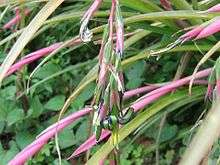Billbergia nutans
| Queen's-Tears | |
|---|---|
 | |
| Scientific classification | |
| Kingdom: | Plantae |
| (unranked): | Angiosperms |
| (unranked): | Monocots |
| (unranked): | Commelinids |
| Order: | Poales |
| Family: | Bromeliaceae |
| Genus: | Billbergia |
| Species: | B. nutans |
| Binomial name | |
| Billbergia nutans H.Wendl. | |
| Synonyms[1] | |
| |
Billbergia nutans (Queen's-Tears) is an epiphytic bromeliad native to Brazil, Paraguay, Uruguay, and Argentina.[1][2][3][4]
This plant is often used as an ornamental plant, and it is probably one of the most common bromeliads grown. It is a durable house plant because this bromeliad can often withstand several periods of neglect. Being epiphytic, bromeliads can grow almost anywhere - on the side of a tree or planted in the ground. They have few roots, just enough to anchor them, and they get their moisture and nutrients from the air like the name suggests. They like humidity and, when it rains, their cups fill with water.[5][6]
During spring and summer you should fertilize with a diluted, balanced, liquid fertilizer. Since bromeliads are epiphytes, foliar feeding may be preferable.[5]
There are ways to force bromeliads to bloom. One way is to add a little Epsom salt (Magnesium sulfate) to their water. The other way is probably better known, especially with other plants - place an apple next to the plant and cover both of them with a plastic bag. Leave them together for a week or more - the bromeliad should bloom within the next 1–2 months.[5]
Varieties
Two varieties are recognized:[1]
- Billbergia nutans var. nutans - Brazil, Paraguay, Uruguay, and Argentina
- Billbergia nutans var. schimperiana (Wittm. ex Baker) Mez - Brazil, Paraguay
Cultivars
|
|
References
- 1 2 3 Kew World Checklist of Selected Plant Families
- ↑ Sant'Ana Melhem, T., das Graças Lapa Wanderley, M., Ehlin Martins, S., Jung-Mendaçolli, S.L., Shepherd, G.J. & Kirizawa, M. (eds.) (2007). Flora Fanerogâmica do Estado de São Paulo 5: 1-476. Instituto de Botânica, São Paulo.
- ↑ Martinelli, G., Magalhães Vieira, C., Gonzalez, M., Leitman, P., Piratininga, A. Ferreira da Costa, A. & Campostrini Forzza, R. (2008). Bromeliaceae da Mata Atlântica Brasileira: lista de espécies, distribuição e conservação. Rodriguésia; Revista do Instituto de Biologia Vegetal, Jardim Botânico e Estaçao Biologica do Itatiaya 59: 209-258.
- ↑ Versieux, L.M., Wendt, T., Batista Louzada, R. & das Graças Lapa Wanderley, M. (2008 publ. 2009). Bromeliaceae da Cadeia do Espinhaço. Megadiversidade 4: 98-110.
- 1 2 3 http://blog.pchomestead.com/2013/02/queens-tears-bromeliad.html
- ↑ Albano, P.-O. (2003). La Conaissance des Plantes Exotiques: 1-324. Édisud, Aix-en-Provence.
- 1 2 3 4 5 6 7 8 9 10 11 12 13 14 15 16 17 18 19 20 21 22 23 24 25 26 27 28 29 30 31 32 33 34 35 36 37 BSI Cultivar Registry Retrieved 11 October 2009
External links
- Billbergia nutans photos